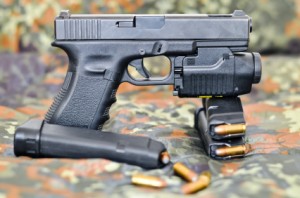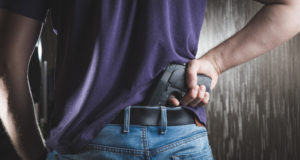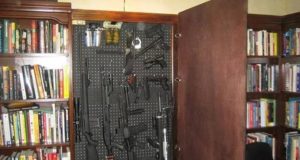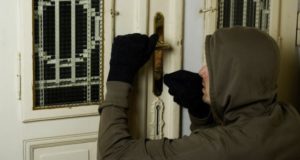Going to the range is a great way to hone your shooting skills. You set up a crisp target in a well-lit shooting lane and blast away. Shooting outdoors is also great fun— the bright sunny days, the well-illuminated targets. See a theme here?
Most of the shooting that enthusiasts engage in is limited to daytime shoots or well-illuminated indoor-range activities. Even more advanced shooters such as IDPA and similar sport shooters will primarily be daytime shooters, with very little (if any) nighttime shooting capabilities. Nighttime or low-light shooting presents its own special challenges, from weapons manipulation in the dark to hitting targets. Low light shooting is a skill that takes practice. The U.S. military fights twenty-four hours per day now using night-vision technology, and every combat soldier is trained on the use of night-vision gear. The enemy attacks whenever they please, not just when it’s light out, and one seldom gets to pick the time and place of an engagement unless they are planning the attack, and maybe not even then.
Night-vision gear is prohibitively expensive for a prepper or off-the-gridder. When a military-grade night-vision monocular costs $3500 or more and equips exactly one person, you can’t be handing them out like candy!
Tactical Lights: A Great Alternative
 Each one of your go to home defense weapons should have a weapon-mounted flashlight specifically designed for that purpose. What this means is a picatinny or M1913 rail-mounted light that has a proper pressure switch and the ability to turn on and off easily and rapidly. What separates a tactical light from a normal flashlight is usually size, cost, and the sheer amount of light that it pumps out. It’s not uncommon for a proper tactical light, however tiny, to pump out 200 lumens, which is enough to practically make a dark room look well lit.
Each one of your go to home defense weapons should have a weapon-mounted flashlight specifically designed for that purpose. What this means is a picatinny or M1913 rail-mounted light that has a proper pressure switch and the ability to turn on and off easily and rapidly. What separates a tactical light from a normal flashlight is usually size, cost, and the sheer amount of light that it pumps out. It’s not uncommon for a proper tactical light, however tiny, to pump out 200 lumens, which is enough to practically make a dark room look well lit.
There are several key reasons why you’d want a weapon-mounted light in the first place. Low light shooting is one of those reasons, obviously. Waking up in the middle of the night to hear glass breaking or a door opening is not how most of us want to experience home defense, but it is greatly exacerbated by picking up a gun from your night stand and blasting away without knowing what you’re shooting at. An exceptionally bright tactical light can also act as a deterrent, temporary blinding someone into either making a mistake or showing them that yes, you do in fact have a firearm trained on them. Additionally, tactical lights are great for daytime use when going from building to building. Spend the day outside then quickly walk into a room with the curtains closed – by the time your eyes adjust to the gloom, you’re already dead – assuming there’s a waiting shooter.
Equipping Your Family for Life With The Necessary Information About Weapons
It’s for these reasons that countless police departments and SWAT teams have mandated the use of weapon-mounted lights. Every major holster manufacturer makes models that are large enough to holster a weapon that has a light mounted on it, and most pistols have forward rails for that purpose. They’re in extremely common use because they work, and add little to no weight to an existing firearm.
As you may have imagined, tactical lights do have their downsides, some of which can be mitigated with training. One inherent downside is that a reputable brand like Fenix or Surefire will cost over $100, sometimes closer to $200 depending on features, which is a lot to pay for what is basically, well, a fancy flashlight. In fairness, most of these lights are extremely bright, made of aircraft aluminum, and are usually waterproof and impact resistant. Additionally, a weapon-mounted light needs to have an excellent and easy way of turning it on. Some use sensitive pressure switches while others utilize switches that resemble paddles.
It’s not so much the turning on of the light that you need to get to…. sometimes it’s the turning off that you need, as in right now. Remember, if you shine your light, the enemy sees it as well, and sometimes you don’t want them to see you until you are ready.
The fact that your potential opponent can see the light is really what separates tactical lights from night-vision gear, which has no such hindrance. Although the benefits of a tactical light outweigh the negatives, some adjustment needs to be made in your weapons handling when the light is in use. Recently, an armed criminal who had barricaded himself in a poorly lit room was able to murder three heavily armed and well-trained SWAT operators because they came in with rifles held closely to their faces in the conventional shooting style. Of course they had their weapon lights on – the criminal simply aimed for the lights and was able to inflict three headshots in a row simply by aiming for the light. Next time you go to the range, try and hit three headshots in a dark room while crouched behind a piece of furniture. It’s hard. Not so hard if an extremely bright light as your target – a light that happens to be right in front of the user’s face! If you use a weapon-mounted light, drop the weapon down so that the light is in front of an armored area (you do have armor, don’t you?) so that the next criminal that shoots at your light hits your armor rather than your face.
How About Lasers?
There are many cases where a laser can be a shooting aid. While it doesn’t provide any illumination, it can nevertheless give you rapid target acquisition with the minimum of fuss. These work best, obviously, after they’ve been zeroed to the weapon. Keep in mind that the tiny red dot a laser puts out gives the illusion of accuracy – your rifle or pistol may or may not always hit what the dot appears on, especially at longer ranges.
Keep Your Handgun Locked and Loaded, Ready For Instant Use – Without Fear Of An Accident!
Lasers come in a variety of flavors, with the low-power red lasers rounding out the cheaper stuff and the higher-power green lasers used for longer-range work. Lasers really work best on short-range targets and on home-defense pistols for novice shooters who don’t have the fundamentals of shooting down. Is this to imply that they encourage bad habits? Absolutely! Still, a setup like a little .38 revolver with Crimson Trace grips and an instruction to your novice wife to simply put the red dot on the bad guy’s chest and pull the trigger is hard to argue with. Professional shooters rarely use lasers since if you need that level of precision in a low light environment, you’ll most likely go for night vision instead.
Whichever one you choose, it’s a great idea to have a source of illumination on your primary home-defense weapon. Whether you use it for conventional illumination or to paint a target, you simply must have at least one go-to weapon that can light up someone’s life—both from the barrel and the flashlight.
©2012 Off the Grid News
 Off The Grid News Better Ideas For Off The Grid Living
Off The Grid News Better Ideas For Off The Grid Living




